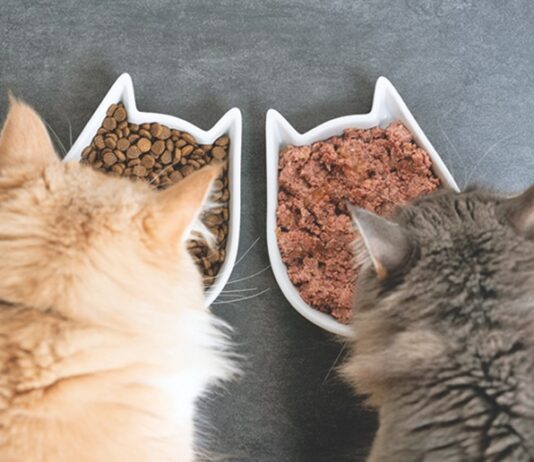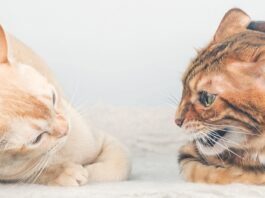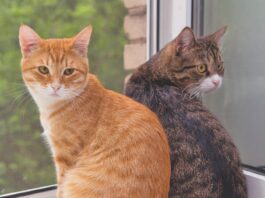Why Do They … Chase Lasers Beams?
Cats love to chase lasers’ points of light, twirling, leaping, pouncing. They engage in the behavior with gleeful abandon for one simple reason: “The jumpy, erratic movement of the light beam can stimulate predatory-like play behavior,” says Pamela Perry, DVM, Ph.D., a lecturer in animal behavior at the Cornell University College of Veterinary Medicine.
Smart Tactics to Stop Destructive Chewing
Pipper loved to lick plastic and crawled eagerly into every plastic bag she could find. But the longhaired black cat’s fascination with plastic eventually progressed to a big problem — chewing the plastic and ingesting tiny pieces to the alarm of her owner, Pamela Perry, DVM, Ph.D., a lecturer in animal behavior at the Cornell University College of Veterinary Medicine. While some dogs chew sundry objects from shoes to sofa legs, cats tend to focus on houseplants, thread, string, yarn and electrical cords. Some, though, like Pipper, chew plastic, and Dr. Perry reached a turning point with the threat to her cat’s health. Ingested plastic could lead to an intestinal blockage. “I had to make sure that all plastic bags were put away,” she says. “They had to be well-hidden or she would find a way to get them.”
Ask Elizabeth: April 2013
First, I think it is great that your friend is taking advantage of the joy that a service dog can bring into people’s lives, and I want to give a shout out to my dedicated canine friends and the wonderful people who work so hard to make their mission possible. These dogs are awesome and are, for the most part, very carefully screened with respect to behavior, so I doubt there will be any problems with the dog having difficulty with the cats. It wouldn’t hurt, however, to speak with the foundation providing the dog to see if it has advice regarding the introduction.
Ask Elizabeth: December 2011
Dear Elizabeth: I have a five-year-old indoor cat, Baby, with whom I’ve shared my home ever since she was born. I’ve never had any other companion animals, so it’s been just Baby and me for all that time. Here’s my problem: I recently became engaged and at some point in the near future will be moving into my fiance’s home. He has two cats — both females. One is just about Baby’s age and the other is probably about seven years old. Neither one of them is very friendly. Naturally, I’m concerned about moving Baby into this new environment. I’m afraid that the animals will fight and hurt each other. I’ll appreciate any advice on how I can best address this dilemma.
Ask Elizabeth: July 2011
Dear Elizabeth: I have four cats in my household and one of them, Tabitha, has a tendency to chew and eat plastic. Ive caught her chewing on plastic bags that Ive carried in from the store, as well as items in the basement that are wrapped in plastic. I worry that she could choke to death or hurt herself somehow. Why does she do this? One of my other cats is aggressive and chases her. Tabitha is afraid and will not fight back; could her plastic obsession be stress-related? Any ideas of what I can do?
Is It Really a Mothers Love?
If anyone has learned to accept the empty nest syndrome, its the mother cat who watches her kittens leave one by one by at about 12 weeks or so - either through adoption or by wandering off to fend for themselves. So its interesting to see how mother cats and their kittens behave when they remain together in the same household. Sibling Rivalry? "The least amount of conflict occurs with cats that have been brought up together," says Katherine A. Houpt, VMD, the emeritus James Law Professor of Animal Behavior at Cornell Universitys College of Veterinary Medicine. "Feline siblings often become friends in the household."
Twos Company – Sometimes
Cats are naturally solitary creatures; in addition, they are also naturally independent and self-sufficient - traits that we alter and/or suppress when we domesticate them. The idea of a second cat can be very alluring: "One cat is so entertaining and such a wonderful companion … two would be twice the fun!" Or, "I want to do my part to ease the burden on my local shelter and give one more cat a good home." These are common thoughts for cat owners and may, in fact, be true; however, the decision to add a second feline family member should not be taken lightly. A second cat can either add joy and companionship, or it can add strife and mayhem.
Twos Company Sometimes
Cats are naturally solitary creatures; in addition, they are also naturally independent and self-sufficient traits that we alter and/or suppress when we domesticate them. The idea of a second cat can be very alluring: "One cat is so entertaining and such a wonderful companion
two would be twice the fun!" Or, "I want to do my part to ease the burden on my local shelter and give one more cat a good home." These are common thoughts for cat owners and may, in fact, be true; however, the decision to add a second feline family member should not be taken lightly. A second cat can either add joy and companionship, or it can add strife and mayhem.
Make Safe Cat-Dog Introductions
Some folks are "dog people," while others have an affinity for cats. But what do you do when enthusiasts of both persuasions share the same home? Despite the conventional wisdom that dogs and cats cant peacefully coexist, both species can inhabit the same space without the fur flying. However, introducing a cat into a dog-centric home requires planning, patience and a commitment to the process. How long it takes to successfully integrate a new cat with a dog depends on the situation, says Katherine Houpt, VMD, PhD, board-certified by the American College of Veterinary Behaviorists and emeritus professor of animal behavior in Cornell Universitys College of Veterinary Medicine. "It can take anywhere from days to weeks, and it varies a lot with the dogs reaction," she says. "I think its important to increase exposure gradually when doing an introduction so you can monitor both animals reactions. That usually happens over a number of days."
Ask Elizabeth: October 2010
My main concern is that Buster, a fierce hunter of mice, will bring about an early demise to any small pets we bring home. Do you have any tips on keeping Guinea pigs (or other small creatures, since Im sure that, once we bring home one, others will follow) safe from cats in the home? And will these precious little beings be stressed, living in the home of a proud hunter? I wouldnt want them to live an unhappy life!
Ask Elizabeth: February 2010
Dear Elizabeth, I have four cats in my household, and one of them, Tabitha, has a tendency to chew and eat plastic. Ive caught her chewing on plastic bags that Ive carried in from the store, as well as items in the basement that are wrapped in plastic. I worry that she could choke to death or hurt herself somehow. Why does she do this? One of my other cats is aggressive and chases her. Tabitha is afraid and will not fight back; could her plastic obsession be stress-related?
Ten Ways to Go Green
It should come as no surprise that Mother Nature is on the verge of taking a permanent sick day. After all, harmful climate changes due to greenhouse gases, air and water pollution, and the destruction of natural habitats are putting our planet and its inhabitants - both two- and four-legged - in peril. Hopefully, many of us have begun to make some changes in our daily lives to help reverse the damage done to, well, everything. But what role can our cats play in being good stewards of our beleaguered planet? There are many practical ways to reduce your felines carbon pawprint, which include switching to a corn or wheat-based cat litter and recycling cat food containers instead of throwing them in the trash. Get a jump start on Earth Day (April 22) by incorporating the following tips into your daily routine. Start out slowly if you wish by trying one or two new tips each week. Encourage your friends, family members and co-workers to join in your quest for a sustainable future. Youll find that its not only fun and easy to "go green," but youll see that you can make a positive and lasting impact on our world, which will please Mother Nature.










